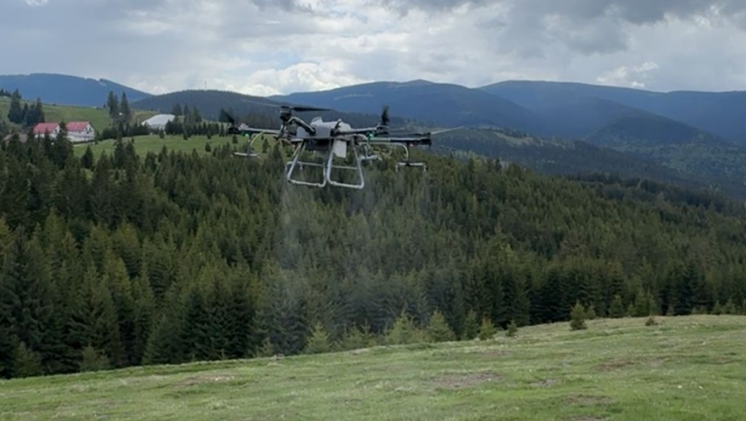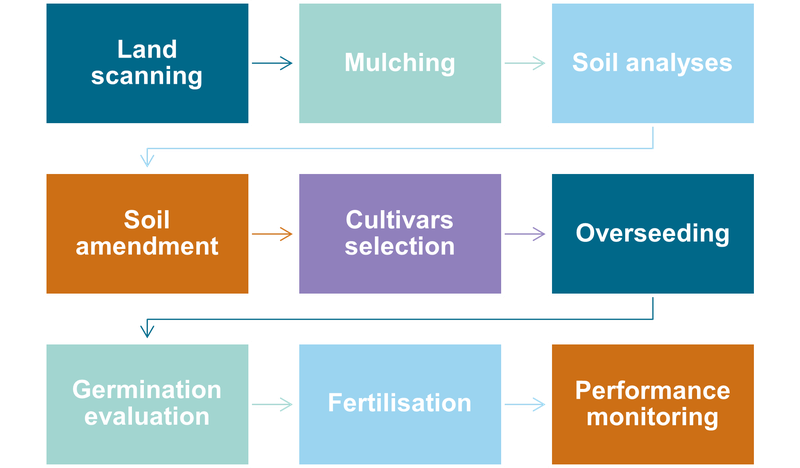Râu Sadului and Cristian are validating a series of mountain meadow revitalisation techniques, covering an area of 40 hectares. For the first time, drones are scanning, seeding and fertilising the meadows in a real-world environment.
Key Learnings
- Applying drones in a real-world environment: Modern and innovative solutions, such as using drones for scanning, seeding and fertilisation activities, support tailor-made adaptation actions under changing climatic conditions. Drones have enabled mapping the intervention areas, assessing vegetation cover and applying soil treatments, like nitrifying bacteria, soil amendments and fertilisers, to improve production conditions.
- Community involvement in the climate change adaptation process: A participatory dialogue involves stakeholders representing civil society, academia, businesses and local decision-makers to develop climate change adaptation strategies. This “bottom-up” approach revealed social and economic realities of the region, as well as opportunities to be considered in the adaptation plan.
- Long-term benefits: Innovative grassland revitalisation techniques, restoring or improving degraded or poorly functioning grassland ecosystems, can support farmers and local authorities in achieving medium- and long-term climate change adaptation outcomes and improve the region’s resilience towards climate change. These techniques boost biodiversity, improve soil health, carbon sequestration, water retention, and productivity.
About the Region
Râu Sadului and Cristian are municipalities and residential villages in Sibiu County, Transylvania, Romania. According to the census from 2021, Râu Sadului had 514 inhabitants. The town area is about 52 km². Cristian lies at an altitude of 444 m and covers an area of approximately 71 km², home to about 4,100 inhabitants. The two villages are located in the Cindrel Mountains, which are part of the Carpathians, shaping the region’s distinct mountainous landscape, featuring forests, alpine meadows, and subalpine grasslands. The characteristic landscape supports traditional pastoral activities, such as sheep grazing.

Climate Threats
The mountains and hilly landscape also influence the area’s microclimate with cool temperatures, high precipitation, and significant seasonal variation. Prolonged summer droughts, warmer winters with less snow cover, and soil erosion due to extreme weather events are becoming more frequent in the region. These changes threaten biodiversity and traditional land-use practices, making grassland revitalisation especially relevant in maintaining ecological balance and supporting rural livelihoods in the area. Climate change has been negatively affecting mountain pastures in the area, changing the vegetation composition, reducing water resources, and increasing exposure to extreme weather events, such as droughts and heavy rains.
These changes lead to biodiversity losses and negatively impact the economic activities of local communities that depend on these ecosystems for pastoral and other agricultural activities. Rising temperatures have severe effects on mountain vegetation, causing species to shift their ranges or leading to the loss of endemic plants, which are adapted to colder and harsher conditions. Climate change has also reduced water availability in mountain pastures, essential for mountain plants and pastoral activities. Heavy rains can also lead to erosion, particularly affecting mountain pastures and reducing grazing areas.
Restoring mountain meadows and adapting to the effects of climate change
In response to the climate threats the region is facing, it became necessary to identify solutions for restoring mountain meadows. Revitalising mountain meadows helps respond to declining nutritional fodder quality as a result of climate change in mountain meadows across Europe, a challenge that threatens biodiversity and prompts the migration of mountain farming communities to lower areas. This can lead to the loss of local traditions, people’s identity and high-quality pasture products. The region is currently known for its high-quality dairy products (e.g. sheep milk cheese – Telemeaua de Sibiu IGP), but if pastures are lost, shepherds may switch to lowland-adapted breeds. In those areas where feed is available, but the quality of the grass is poorer, which reduces the quality of the animal products.
The MountResilience project – whose team involves researchers, technical experts, local authorities and financial experts – tested various mountain meadow revitalisation techniques in a real-world environment in the Cindrel Mountains, including drone-assisted scanning, seeding, and fertilisation. The case study area covers approximately 40 hectares in Râu Sadului and Cristian. In Râu Sadului, shepherds signed agreements for using the plots owned by the municipality to implement the project.
On-site interventions
Before taking action on the ground, the project team studied why the once vibrant mountain meadows were declining. Drone surveys with multispectral cameras revealed degraded, acidic soils and invasive vegetation replacing native grass species. Those analyses enabled mapping the intervention areas, assessing vegetation cover. Soil treatments, like nitrifying bacteria, soil amendments and fertilisers improved production conditions. Drones also enabled overseeding steep slopes, where overseeding with machines is not possible.

Figure 1: Automatic soil sampling and manual forage analysis. Image Credit: MountResilience.
To restore biodiversity, the team also removed unwanted plants, improved soil health with biological and mineral treatments, and reseeded with productive species. Early results show promising vegetation recovery and renewed ecosystem vitality. On the ground, soil samples were collected, and botanical surveys recorded the species that remained. Restoring vegetation is not a one-size-fits-all task. The team tested several seed mixtures, carefully designed for mountain grassland restoration, combining highly productive grasses and native legumes for nitrogen fixation and biodiversity support. The composition varied by altitude and soil type, ensuring local adaptation and long-term stability.
Aerial images allowed estimating vegetation cover, and drones enabled applying nitrifying bacteria and soil amendments (calcium carbonate) to improve fertility and growing conditions for productive plant species. After implementing the adaptation actions, within a few months, a visible transformation took place. By early summer, healthy vegetation began to return thanks to favourable conditions and careful soil management. To support long-term fertility, the project team applied targeted fertilisation (a mixed organo-mineral fertiliser at a rate of 200 kg/ha) to strengthen plant growth and ensure lasting meadow recovery.

Figure 2: Loading a drone with mineral fertilizer. Image Credit: MountResilience.
Observed effects included:
- Enhanced nutrient availability through optimised nutrient input;
- Accelerated organic residue decomposition, promoting the recycling of mulched biomass and nutrient release;
- Improved biological nitrogen fixation, increasing soil fertility and supporting long-term pasture productivity.
The new vegetation did not just cover the soil – it anchored it, fed it, and restored balance. Some of the tested seed mixtures flourished beyond expectations, attracting pollinators, grazing animals, and life back to the land. The post-establishment monitoring phase revealed clear differences in the performance of the tested seed mixtures, reflecting both their genetic composition and adaptability to local soil conditions.
The evaluation confirmed that species diversity and functional balance were key to the success of these mixtures. Mixtures combining deep-rooted grasses with nitrogen-fixing legumes performed best, ensuring both soil stability and sustained productivity. Performance differences also reflected site-specific soil properties: Nutriherb excelled in fertile, balanced soils; Kombi White adapted to stony, compacted soils; and Beefmaster proved most effective under grazing and climate stress conditions. Overall, the results demonstrate that tailoring seed mixture composition to local ecological conditions is essential for achieving lasting grassland revitalisation, biodiversity enhancement, and rural productivity gains.
Community involvement in the climate change adaptation process
The regional demonstrator in the Cindrel Mountains brought together citizens, researchers, businesses and local authorities to co-develop climate adaptation strategies through a bottom-up approach. A series of online and on-site meetings enabled dialogue and feedback on proposed solutions, leading to the creation of an informal Local Consultative Council open to all interested participants. Local knowledge gathered through this process now informs the regional adaptation strategy and will be shared through training and communication activities.
The nutritional value of mountain pastures has deteriorated enormously in the last decade. We are testing innovative solutions – including using drones for scanning, seeding and fertilisation activities – to revitalise these regions.
Claudiu Șerban, Agronomic engineer at Research and Development Institute for Montanology Cristian – Sibiu
Assuring long-term benefits for biodiversity and local communities
The revitalisation technique that is currently being validated includes soil amendments, fertilisers, and seed mixtures. It aims to support local authorities and farmers in achieving long-term biodiversity and community benefits.

Figure 3: Intervention flow on the meadow. Image Credit: MountResilience.
To revitalise the meadows and ensure long-term biodiversity and community benefits, the on-site interventions needed to:
- Ensure favourable habitat conditions for local plant and animal speciesby removing unwanted vegetation, adjusting soil pH, promoting the breakdown of biomass residues to release nutrients by using nitrifying bacteria, as well as applying missing essential nutrients (e.g. phosphorus).
- Reduce erosion and improve soil structure to increase water retention capacity by restoring the vegetation cover using highly productive seed mixtures. Plant roots reduce run-off and prevent the loss of soil.
- Create a favourable environment for animal grazing, which allows an ideal symbiosis between the vegetation and the pastured animals. Some of the tested plant mixtures were preferred by grazing animals, who, in return, released nutrients (manure) in those areas, which will further support plant growth. This beneficial impact improves the animals’ milk and meat productivity, benefiting the socio-economic development of the mountain area.
- Enhance biodiversity by restoring soil fertility, which also supports other local species that could be lost if meadows are replaced by forests.
Figure 4: Expected results after revitalisation intervention. Image Credit: MountResilience.
Summary
In the Romanian mountain communities of Râu Sadului and Cristian, innovative techniques are being used to restore 40 hectares of degraded mountain meadows, addressing the growing impacts of climate change such as drought, biodiversity loss and soil erosion. Drones for scanning, seeding and fertilisation support a modern, data-driven approach to adaptive land management. Strong community engagement complemented the technological innovation, as local stakeholders, including civil society, researchers, farmers, and decision-makers, worked together through a participatory process that led to the creation of a Local Consultative Council. The revitalisation efforts improved ecological functions like soil health, water retention and biodiversity, while also strengthening the region’s socio-economic resilience by enhancing pasture productivity and preserving traditional livelihoods.
